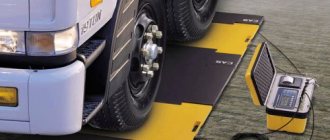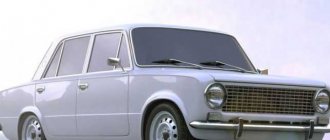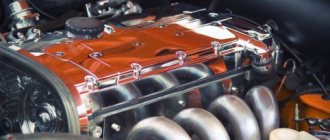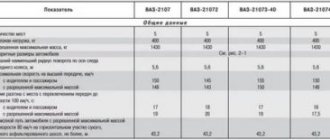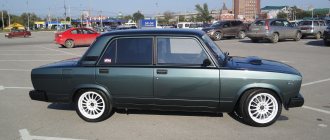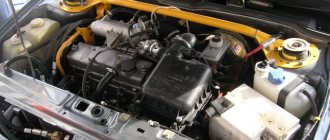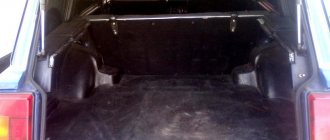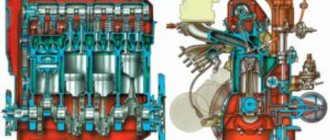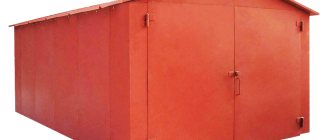| Options | Dimensions | Weight, kg |
| 1.5 MT Basic | 4122 x 1650 x 1402 | 985 |
| 1.6MT0 | 4122 x 1650 x 1402 | 985 |
| 1.6 MT Basic | 4122 x 1650 x 1402 | 985 |
| 1.6MT0 | 4122 x 1650 x 1402 | 985 |
| 1.6MT0 | 4122 x 1650 x 1402 | 985 |
| 1.6MT2 | 4122 x 1650 x 1402 | 985 |
| 1.6MT0 | 4122 x 1650 x 1402 | 985 |
| 1.6 MT 211440-24 | 4122 x 1650 x 1402 | 985 |
| 1.6 MT 211440-26 | 4122 x 1650 x 1402 | 985 |
| 1.6MT0 | 4122 x 1650 x 1402 | 1060 |
| 1.6MT2 | 4122 x 1650 x 1402 | 1060 |
| 1.6MT0 | 4122 x 1650 x 1402 | 1060 |
| 1.6MT1 | 4122 x 1650 x 1402 | 1060 |
How much does a VAZ-2114 car weigh?
The fourteenth model was first released for sale in 2002.
In fact, this is an updated “nine”, which is loved by many car enthusiasts in the post-Soviet space. Improved appearance and technical equipment have significantly expanded the tuning possibilities. In this article we will look at the main technical characteristics of the model, and you will also find out how much the VAZ-2114 weighs.
Technical specifications include:
- Aerodynamics.
- Dimensions.
- Clearance.
- Vehicle weight.
- Suspension features.
- Body information.
- Transmission.
- Engine performance.
Maintenance schedule
To avoid having to carry out expensive overhauls of the Lada Samara 2114 yourself, you should follow the manufacturer’s recommendations for servicing the internal combustion engine:
| Maintenance object | Time or mileage (whichever comes first) |
| Timing belt | replacement after 100,000 km |
| Battery | 1 year/20000 |
| Valve clearance | 2 years/20000 |
| Crankcase ventilation | 2 years/20000 |
| Belts that drive attachments | 2 years/20000 |
| Fuel line and tank cap | 2 years/40000 |
| Motor oil | 1 year/10000 |
| Oil filter | 1 year/10000 |
| Air filter | 1 – 2 years/40000 |
| Fuel filter | 4 years/40000 |
| Heating/Cooling Fittings and Hoses | 2 years/40000 |
| Coolant | 2 years/40000 |
| Oxygen sensor | 100000 |
| Spark plug | 1 – 2 years/20000 |
| Exhaust manifold | 1 year |
If consumables are replaced within the recommended time frame, the operational life of the internal combustion engine will increase.
Have aerodynamics improved compared to its predecessor?
The VAZ-2114 has improved aerodynamic characteristics thanks to modified body lines that provide good streamlining. This significantly reduced counter resistance while driving.
Aerodynamic improvements have affected the air mass separation point. To do this, we changed the angle of the hood and worked with the wings.
The result of the improvements is that air masses are now directed under the bottom to a lesser extent. Most of the flow goes to the hood and body. Accordingly, the lift force indicator changed, and both axles were unloaded. Now the driver can feel more confident when driving at high speeds.
Engine tuning
For naturally aspirated engines, the following type of tuning is usually used:
- receiver complete with 54 mm throttle body at the inlet;
- straight-through spider 4/2/1 at the outlet;
- camshaft Nuzhdin 10.93 or Dynamics 118 instead of the factory equipment.
Camshaft Dynamics 118
The dynamics of the internal combustion engine will improve, the power will increase to 85 - 90 hp. With. Next is just lightening the crankshaft, modifying the intake manifold and milling the cylinder head.
For 16 valve engines, tuning has the same principles, since chipping it does not make sense. To achieve 120 l. With. You can increase the damper to 56 mm, use a direct-flow type exhaust, Nuzhdin 8.85 or Stolnikov 8.9 280 camshaft.
Thus, only one engine, modification 21126, bends the valves on the VAZ 2114. All other engines are considered safe and provide a real service life of about 270,000 km.
Popular faults
Due to the imperfect quality of the unit and the large number of low-quality spare parts, the motor and attachments require increased attention.
Main problems and possible causes:
- Unstable idling of the VAZ 2114, the engine stalls after starting. Cause – Coking of the idle speed controller (IAC), throttle position sensor, vacuum seal “drizzle”, unreliable signals from the mass air flow sensor;
- Starting has deteriorated, the engine is running rough - the reason may be: incorrect valve adjustment, lack of compression in one of the cylinders (the valve may have burned out), wear of the valve springs, air leaks (check the connections of the hoses and pipes going after the mass air flow sensor and to the vacuum valve, valve hose purging of the absorber, tight fit of the injectors to the cylinder head), malfunction of the ignition module, spark plugs do not produce a spark, inoperability of high-voltage wires, incorrect valve timing (the timing belt may have slipped a few teeth);
- The VAZ 2114 engine has lost throttle response and does not pull. The breakdown is possible due to a malfunction of the ignition module (symptoms appear when the engine is warm), a clogged catalyst, the fuel pump does not create the required pressure, a dirty air filter, air leaks, carbon deposits on the spark plugs, lack of compression;
- Extraneous knocking, noise and vibration of the VAZ 2114 engine. Breakdown may occur because valve clearances need adjustment, sagging valve springs, sagging seats, wear of the main bearings of the crankshaft or connecting rod bearings (it is possible that the pistons themselves are knocking), hydraulic compensators, wear of the engine mounts (pillows);
- Does not show the engine temperature of the VAZ 2114. Occurs due to a malfunction of the coolant temperature sensor (the sensor screwed into the cylinder head is responsible for the readings on the instrument panel), open circuit, oxidation of contacts, a malfunction in the indicator on the dashboard;
- The engine is heating up. Thermostat failure (liquid circulates only in the engine cooling jacket). When buying a thermostat, look in the instructions for what engine operating temperature it is designed for (for the engines in question this is 95-103 degrees); Damage to the water pump impeller, malfunction of the fan switch sensor, or the fan itself does not work.
Exterior changes
The interior was updated with a European dashboard, an adjustable steering wheel and a completely new heating system.
The rear seats can be folded down to create a larger trunk if needed. Additionally, the VAZ-2114 is equipped with the following options:
- Electric windows.
- Heated seats.
- Central locking.
- Factory tinting in accordance with GOST requirements.
- The sills have fairings and moldings.
- Alloy wheels.
- Fog lights.
The maximum configuration of cars comes with an on-board computer that displays the following information:
- Average driving speed.
- Gasoline consumption.
- Travel time.
- Outside air temperature.
- Vehicle electrical network voltage and many other parameters.
Trunk Features
The features of the luggage compartments of various modifications of models 2113, 2114, 2115 include an acceptable level of capacity and the possibility of transforming the interior to increase useful volume.
The VAZ 2115 is distinguished by a convenient loading height and a larger trunk volume than the Lada 2115. Otherwise, the design of the cargo compartment is identical to other models.
Cars are equipped with a standard shelf; it is installed vertically and separates the luggage compartment and the interior. If necessary (for example, when transporting large cargo that requires folding the rear seats), this shelf and the vertical curtain can be removed.
On Lada 2113, 2114, 2115 cars, under the “floor” of the trunk there is a niche for storing a spare wheel and tools necessary for quickly repairing small faults that may arise along the way.
The VAZ 2115 is distinguished by a convenient loading height and a larger trunk volume than the Lada 2115. Otherwise, its design is identical to other models.
The VAZ 2113, 2114, 2115 models, which are modifications of the “eights”, “nines” and “ninety-nines”, respectively, have become more ergonomic, easy to use, and practical. The cars received spacious luggage compartments, which increased the amount of cargo transported. The presence of a number of shortcomings does not deter drivers: some inconveniences can be corrected on their own.
Cars of the VAZ 2113, 2114, 2115 family are popular not only in Russia, but also in the CIS countries. This is due to the wide distribution of these cars, their unpretentiousness, relative reliability, maintainability and cost. The machines have an acceptable loading niche capacity, which makes them convenient to use for solving everyday household problems or running a small business.
A few words about technical characteristics
The VAZ-2114 hatchback differs from previous models in the following parameters:
- The length of the five-door body is 4122 cm.
- Width – 1650 cm.
- Height – 1402 cm.
- Unlike the base model 21093, the car has become slightly longer.
- Weight – 985 kg. The weight of the loaded vehicle is 1410 kg.
- Towing trailers without brakes - weight no more than 300 kg, with brakes - 750 kg.
- The wheelbase is 1.4 m (front wheels).
- 1.37 m (rear wheels).
- Trunk volume – 330 liters. With seats folded down – 600 liters.
- The clearance to the crankcase is 16 cm, to the pan it is a centimeter more.
VAZ 2115
The trunk volume of the VAZ 2115 is 427 liters with the seats folded down; if they are unfolded, the capacity increases to 700 liters. The dimensions of the luggage compartment have been increased, thanks to which even large-sized cargo can be transported on the fifteenth model.
The advantages include ease of dismantling, installation of a shelf, as well as a convenient height for loading. It is located almost at the level of a car bumper.
Drivers often improve sound insulation and standard luggage compartment lining. They install an electric drive for opening the lid, install lighting, and construct boxes for storing small items (however, due to their installation, the trunk significantly loses volume).
Features of the internal combustion engine on the VAZ-2114
The very first cars of this modification came with a 1.5 liter engine. Their power was 57.2 kW.
In 2007, they began installing a 1.6-liter four-stroke engine with an output of 80 horsepower. This internal combustion engine complies with EURO-3 parameters. The latest modification of the fourteenth model is available with a sixteen-valve engine that develops a power of 89 hp. With.
Acceleration to 100 km/h is 13 seconds, which was achieved through distributed injection. The maximum speed of the VAZ-2114 is 160 km/h with a fuel consumption of 9 l/100 km in the city.
It is important to note that the ceramic catalyst is located next to the engine, which was not the case in previous models. The designers changed the cylinder block, increasing their volume and height (by 0.23 cm).
A little history
In the period from 1980 to 1984, AvtoVAZ worked quite closely with the giant of the modern automotive industry - Porsche.
At that time, joint work was underway on the VAZ 2108 model. Already in the period from 1987 to 1991, the companies began working on a new car - the VAZ 2110 with a 1.5-liter engine.
Despite the cooperation agreement regarding only these two models, specialists did not miss the opportunity to work on the entire line being developed at that time. This also applied to the VAZ 2109 model, which became the successor to the modern fourteenth.
Predecessor
Not everyone knows about this fact of cooperation with a German company, which was already considered a model of the automotive industry. But this is precisely what served as a springboard for the creation of reliable and very interesting domestic cars.
Large-scale production of the successor to the Russian-German “nine” in the person of the VAZ 2114 began in 2003. It is noteworthy that first, in 2001, the VAZ 2115 appeared, and in 2004, the VAZ 2113.
The fourteenth model can be considered an improved “nine”, and the VAZ 2113 is a modified version of the eight.
According to research, the VAZ 2114 is on the list of the most common models in Russia.
Differences from the “nine”
There are not so many differences between the VAZ 2114 and VAZ 2109 in terms of bodywork. The updated car received new:
- Front part of the body;
- New lens shape;
- New hood;
- Different radiator grille;
- Improved quality of plastic on bumpers;
- Spoiler;
- Moldings;
- Threshold covers.
There were much more changes inside. But in many ways the difference is determined by the class of the car, that is, its equipment. For the VAZ 2114 there were three equipment options - Standard, Norma and Lux.
So what has changed inside?
- There was a new dashboard with a dashboard without an upper glove compartment. The Lux package has a recessed part. There are a pair of cup holders on the lower glove compartment lid.
- The Norma and Lux trim levels are equipped with electric windows.
- The steering wheel is adjustable for tilt. It is noteworthy that the steering wheel of the VAZ 2114 and the steering column are taken from a dozen.
- Seat belt fasteners are also taken from dozens.
- The dashboard is used from the fifteenth VAZ model.
- An adjustable interior light is located on the ceiling.
- The maximum configuration has a full-fledged on-board computer.
- The stove became more powerful, but this increased the noise level.
Key Benefits
Obviously, the fourteenth model from AvtoVAZ is not as simple as many people think at first glance. Otherwise, it simply would not have been so popular and in demand.
Here's an example of a few of the most significant benefits.
- Excellent aerodynamics. Considering the power of the engines and the aerodynamic capabilities of the body, this is one of the best models created for high-speed driving. Carry out chip tuning to increase engine power or organize more serious modifications to the engine, and you can extract good horsepower. In this case, the engine resource will not be particularly affected.
- Great looks. Obviously, the VAZ 2114 looks much more interesting and attractive than the Nine. At the same time, the model was literally created for tuning. It is not necessary to increase power. An original body kit - and you are a road star. But in everything you need to know when to stop, so as not to turn real tuning into a collective farm.
- Youth orientation. The younger generation of drivers was unlikely to be very interested in sevens, tens or sixes from AvtoVAZ. Yes, they were cheap and were bought most often due to the lack of alternatives. But with the advent of the VAZ 2114, many realized that a beautiful, domestic car had finally come out, which looked no worse than its imported sporty counterparts. At the same time, in terms of prices they could not compete even close to the fourteenth.
- Possibility of improvements. Until now, for the VAZ 2114, despite the model being discontinued, many elements are available for external and internal tuning. Body kits, trims, moldings, spoilers, seats, optics - everything to suit your taste and budget. What’s most interesting is that for little money you can organize a large-scale modification, changing the standard VAZ 2114 beyond recognition.
Characteristics of motors 2114
Since the release of the Lada Samara VAZ-2114, the technical characteristics of the gasoline drive have been constantly improved. Owners of domestic cars, in principle, do not have questions about what kind of oil to pour into the engine, since standard requirements apply for Zhiguli, Lada and Samara - 5W30 or 10W30.
In addition, you should know what kind of oil to use in transmission gears - the instructions from the AvtoVAZ manufacturer recommend using the GL-4 group of lubricants with a viscosity of 80W85 (mineral), 75W90T (synthetic) or 85W90 (semi-synthetic).
After filling with synthetics, the box becomes noisy, the oil is more expensive, but the lubricant is mostly imported, which provides additional guarantees. Domestic manufacturers most often produce semi-synthetics of average quality for engines and transmission gearboxes.
The technical characteristics of the engine are as follows:
| Characteristics | Engine modification | ||||||||
| 2111 | 21114 | 11183 | 21124 | 21126 | |||||
| Years of installation | 2003 – 2007 | 2003 – 2007 | 2007 – 2009 | 2009 – 2013 | 2009 – 2013 | ||||
| Volume | 1500 cm 3 (97.9 hp) | ||||||||
| Torque moment | 115.7 Nm (3200 rpm) | 125 Nm (3000 rpm) | 120 Nm (3200 rpm) | 131 Nm (3700 rpm) | 145 Nm (4000 rpm) | ||||
| Weight | 127.3 kg | 112 kg | 112 kg | 121 kg | 115 kg | ||||
| Compression ratio | 9,8 | 9,6 | 9,6 | 10,3 | 11 | ||||
| Nutrition | injector | ||||||||
| Engine diagram | Inline (L) | ||||||||
| Ignition | module | coil | coil | coil for each spark plug | |||||
| Number of cylinders | 4 | ||||||||
| Location of the first cylinder | TVE | ||||||||
| Number of valves on each cylinder | 2 | 2 | 2 | 4 | 4 | ||||
| Cylinder head material | aluminum alloy | ||||||||
| Intake manifold | aluminum | plastic with receiver | |||||||
| An exhaust manifold | with catalyst | ||||||||
| Camshaft | 2110 | 2111 | 2112 | ||||||
| Cylinder diameter | 82 mm | ||||||||
| Piston stroke | 71 mm | 75.6 mm | |||||||
| Pistons | Yes | No | No | Yes | No | ||||
| Valve bend | Yes | No | No | Yes | No | ||||
| Crankshaft | 2112 | 11183 | |||||||
| Fuel | AI-95 | ||||||||
| Environmental standards | Euro 4 | Euro 2 – 4 | Euro 3 – 4 | ||||||
| Fuel consumption highway/combined cycle/city | 5,7/7,3/10 | 6/7,3/10,4 | 6/7,8/11 | 5/7/9,5 | 5,4/7,2/9,8 | ||||
| Oil consumption per 1000 km | 0,7 | 0,5 | |||||||
| Engine oil for 2114 | 5W-30 and 10W-30 | ||||||||
| Engine oil volume | 4 l | 3.8 l | 3.5 l | 3.6 l | |||||
| Operating temperature | 95° | ||||||||
| Motor life | declared 150,000 km, real 250,000 km | ||||||||
| Adjustment of valves | washers between camshaft cams and tappets | hydraulic pushers | |||||||
| Cooling system | forced, antifreeze/antifreeze | ||||||||
| Coolant quantity | 7.8 l | ||||||||
| water pump | plastic impeller | ||||||||
| Candles for 2114 | A17DVRM, BPR6ES | AU17DVRM, BCPR6ES | |||||||
| Gap between spark plug electrodes | 1.1 mm | ||||||||
| Timing belt | length 698 – 1125 mm depending on attachments | ||||||||
| Cylinder operating order | 1-3-4-2 | ||||||||
| Air filter | Nitto, Knecht, Fram, WIX, Hengst | ||||||||
| Oil filter | Mann W914/2 | ||||||||
| Flywheel | 2110 | ||||||||
| Flywheel mounting bolts | M10x1.25 mm, length 26 mm | ||||||||
| Valve stem seals | code 90913-02090 inlet light code 90913-02088 exhaust dark | ||||||||
| Compression | from 14 bar | ||||||||
| XX speed | 750 – 800 | 800 – 850 | |||||||
| Tightening force of threaded connections | spark plug – 31 – 39 Nm clutch bolt – 54 – 87 Nm bearing cap – 59 Nm (main) and 43 – 53 Nm (rod) cylinder head – four stages 20 Nm, 71 Nm + 90° + 90° | ||||||||
For high-quality maintenance of internal combustion engines, the engine manufacturer issues a manual containing a description of the drive parameters, the frequency of replacing consumables and step-by-step repair operations. The same operating manual recommends the volume of oil in the gearboxes in the engine.
Other parameters of VAZ 2114:
| Total weight of the VAZ 2114 car | |||
| General view General view of the car | Curb weight min (kg) Minimum vehicle weight for different modifications of VAZ 2114 | ||
Data are presented in kilograms (kg)
Caution: the above data are official figures from manufacturers, however, please note that the information is for reference only and does not guarantee absolute accuracy.
Source
